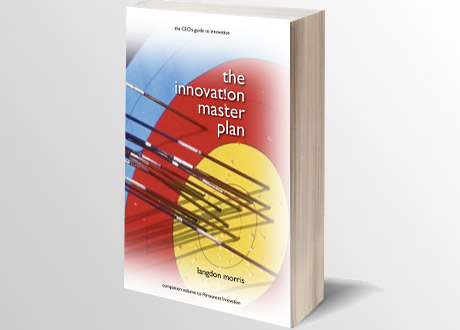By: René van der Hulst
Many companies tout innovation in their marketing. Being perceived as innovative is important. But the message and reality can only diverge temporarily. A new book by Langdon Morris is providing a simple but very effective framework to guide CEOs as they address what many perceive as the dilemma of innovation.
If companies do not keep up with the evolving marketplace they will rapidly loose mind share, market share and eventually go out of business. However, many CEOs are facing a dilemma. They see innovation as important but based on the pressing need for short term financial results, they worry that a focus on innovation will distract their organizations, and require investments they cannot afford. For those CEOs, the latest book by Langdon Morris has much to offer.
You recognize a real expert when (s)he is able to explain a complex subject clearly and understandably. That is exactly what Langdon Morris has done in “The Innovation Master Plan”, by providing a simple but very effective framework to guide CEOs as they address the dilemma of innovation.
Why?
The first chapters address the question of “Why”, an important break with the traditional approach to innovation, which typically starts with ideation. Morris makes the point that successful innovators are those who define their strategic intent first, taking into account key trends society and technology. Using models of risk and reward applied to the uncertainty of the innovation options, they develop portfolios of innovation investments and identify many unknowns and questions. The purpose of research is then to answer these questions and clarify the unknown in a targeted and efficient way.
What?
The chapters addressing the “What, describe the process of creating and managing these innovation portfolios in great detail, covering topics including risk management and the need to take the right kind of risks, as disciplined failure is essential for successful innovators. The section ends with a description of how to create the ideal innovation portfolio.
How?
The “How” provides a holistic view of the innovation process. It describes in more detail the stages of innovation research and offers a comprehensive set of possible metrics. Keeping in mind the need of speed to market, the author stresses the importance of project management in innovation development and the need for short feedback loops in the communication between strategy, targeting, research, development, market development and sales.
Who?
The section on “Who” introduces three key roles that compose the innovation culture. It contrasts that innovative culture with a backward looking status quo and provides much guidance on the type of leadership that is required to enable success.
Where?
In “Where”, the author describes the principles of the innovation infrastructure: open innovation, collaboration, physical work spaces and virtual work spaces. He highlights the principle that since innovation comes from engaged and focused teams of people working together, it is important to facilitate the collaborative process and provides examples of the actions that can make the difference.
The subtitle of the book is “the CEO’s guide to innovation”. This implies a strategic perspective and an approach grounded in reality which does not oversimplify. In addition, it raises the expectation that the book will define the type of leadership that is required to implement an innovative culture. Langdon Morris clearly delivers to that expectation. The many examples help clarify what works and what doesn’t work, and bring the topics alive. And the sections “taking action” provide clear starting points for the creation of your own Innovation Master Plan.
However, not every business can afford – time wise or cost wise – to build an organizational infrastructure required for an end-to-end innovation process. The consideration of what to keep in house and what to do with partners is important strategically, and unfortunately the book does not give a lot of guidance in that area.
But even without that, I would add that as I have led innovation programs in the high-tech sector, I recognize now how much more effective we could have been if we would have had the benefit of reading this book first.
In summary, this is a comprehensive and very readable book. It doesn’t leave you in a swamp of theory and helps enormously with the formulation of a concrete and realistic plan to create a future for your business. If you read only one book on innovation this year, make it this one.
By René van der Hulst
About the Author
 René van der Hulst is owner of in2lead and operates as consultant in advisory and executive roles related to innovation projects. He has more than 20 years experience in the telecommunication industry, and at Lucent Technologies led the team introducing data solutions for enterprise customers of large mobile operators.
René van der Hulst is owner of in2lead and operates as consultant in advisory and executive roles related to innovation projects. He has more than 20 years experience in the telecommunication industry, and at Lucent Technologies led the team introducing data solutions for enterprise customers of large mobile operators.
The Innovation Masterplan is presented in a series of 11 chapters at InnovationManagement.se

